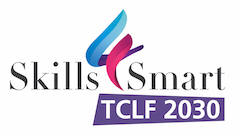Designing an innovative TCLF curriculum, responding to present and future needs of employers is key to sectoral economic development.
This article proposes a curriculum development model that should be a part of the education and training ecosystem that is in line with future needs [1]
After a digital and industrial revolution
The emerging professions have to take into consideration all consequences related tothe digital transformation and of the Industrial Revolution 4.0 that leave and impact on the economy, in particular on the TCLF industries.
What plays crucial role?
Technology changes of how people learn. By improving access for learners to Massive Online Open Courses and, offering flexibility in terms of time and place that can increase employees participation in learning.
The cooperation among different actors – VET providers, clusters of innovation, companies, professional associations, trade unions – that focuses strongly on curriculum development and delivery, and that is featuringa strong component of work-based learning, which leadstowards an innovative, future-oriented TCLF industries.
New challenge: reducing the gap
As a result, the gap between skill supply and demand has the potential to decrease. However, effort should also be made to involve Industry 4.0 solution providers in the process. They can provide valuable inputs related to technologies that will come into existence in the future, based on which the training curriculum can be modified and improved even further.
Beyond the proposed innovation and the contents developed for a curriculum, the way of approaching its construction is very important. The curriculum is organized into different modules. Each of them is structured to acquire proven learning acquisitions while assuring a authentic learning environment. Hence the certificaton by assigning microcredentials[2] and micro-qualifications, known to be one of the best successful methodological approaches.
Curriculum as a tool for meaningful changes
A new or modified curriculum is not exclusively about promoting skills relevant to the labour market but it also addresses a broader set of competences, including soft skills, relevant to life and society in general. It must also clarify the role of transversal skills and competences related to communication and problem-solving. Moreover, they should reflect the character of the input of various stakeholders from education and TCLF industries as well as one of national authorities in charge of qualifications recognition.
At the European level, there may appearconcerns regarding the approach to curriculum development and implementation, however the models can inspire and support the Member States in modernising and adapting the curriculum to current and future developments in the economy and society, hence their adequacy and quality are of key importance.

- Strategy refers to defining core values, commitments, opportunities, resources and capabilities of an educational/training institution for developing a curriculum for an innovative TCLF industries. Specifically, the elements of strategy include assessment of learner’s needs, development of curriculum goals and learning outcomes.
- Collaboration refers to connecting individuals and institutions by facilitating the exchange of practices and resources to improve the educational offer. Special emphasis needs to be put on new collaboration patterns among VET institutions, companies, clusters of innovation, partnership networks, in order to empower learners to collaborate with peers and organizations and increase level of engagements.
- Content refers to specific principles related to syllabus design, leading to the acquisition of learning outcomes necessary to adapt to the present and future requirements of the labour market, but also of those learning outcomes corresponding to the areas of transversal skills, or soft skills.
- Delivery mechanisms refer to how learners experience and access vocational education and training: face-to-face interaction between teachers/ trainers and learners (e.g. lectures, seminars, workshops), electronic or blended delivery (education that combines multiple types of delivery). An important role belongs to methods addressing the role of technology-enabled learning, including traditional e-learning, m-learning MOOCs, gaming, virtual and augmented reality, AI , IoT, etc. In last years, MOOCs have been rapidly gaining popularity, allowing hundreds of learners across the world to follow courses in a self-paced manner.
- Assessment refers to the various methods of evaluation and their relevance to different kinds of educational offerings. Common methods of assessment include: self-assessment, peer-assessment, and formal assessment.
- Self-assessment involves learners evaluating their work and progress towards the learning objectives. Through self-assessment, learners are encouraged to reflect on identifying their knowledge and skills gaps, set realistic goals and decide their pace going forward.
- Peer assessment, in a collaborative learning context, allows for learners to evaluate each other and such an assessment may focus on soft skills like teamwork but also professional skills.
- Formal assessment refers to evaluation of learners’ responses in quizzes, interviews, assignments, presentations, practical examinations and other means of formal evaluation, or digitized or automated modes of assessment. Formal assessment is associated with the quality and rigor of formal education ensuring the recognition of achieved learning outcomes.
- Recognition refers to the process of issuing a certificate, a diploma or title acknowledging that learning outcomes knowledge, skills have been achieved.
In conclusion, the digital and industrial revolution did not leave the TCLF sector unscratched. Different adaptations and changes must take place. Whether it concerns knowledge or skills, the curriculum is a key tool to initiate a new area of development and excellence. It will take a major role in making the sector more attractive to youngers and efficient to the businesses. But above all, improving the industries’ future and perspective of its workers.
[1] European Commission – Curriculum Guidelines for Key Enabling Technologies (KETs) and Advanced Manufacturing Technologies (AMT), January 2019
[2] Micro-credentials can be defined as documented statements that acknowledge a person’s learning outcomes, which are related to small volumes of learning and that for the user are made visible in a certificate, badge, or endorsement (issued in a digital or paper format), European Skills Agenda for sustainable competitiveness, social fairness and resilience, https://ec.europa.eu/social/main.jsp?langId=en&catId=89&furtherNews=yes&newsId=9723
Ressources:
European Skills Agenda for sustainable competitiveness, social fairness and resilience, https://ec.europa.eu/social/main.jsp?langId=en&catId=89&furtherNews=yes&newsId=9723
European Commission – Curriculum Guidelines for Key Enabling Technologies (KETs) and Advanced Manufacturing Technologies (AMT), January 2019
Author: Camelia Guetu – CNDIPT


